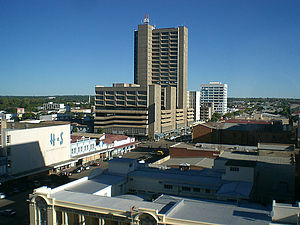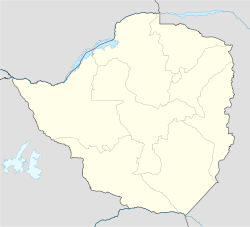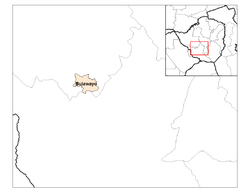
Bulawayo
Did you know...
This Wikipedia selection is available offline from SOS Children for distribution in the developing world. With SOS Children you can choose to sponsor children in over a hundred countries
| Bulawayo | |||
|---|---|---|---|
| Bulawayo | |||
|
|||
| Nickname(s): 'City of Kings', 'Skies', 'Bluez' or 'Bulliesberg' | |||
| Motto: Si Ye Phambili | |||
|
|
|||
| Coordinates: 20°10′12″S 28°34′48″E Coordinates: 20°10′12″S 28°34′48″E | |||
| Country | Zimbabwe | ||
| Province | Matabeleland North | ||
| District | Bulawayo | ||
| Founded | 1871 | ||
| Government | |||
| • Mayor | Thaba Moyo | ||
| Elevation | 1,358 m (4,455 ft) | ||
| Population (2005) | |||
| • Total | 1,500,000 | ||
| estimated | |||
| Time zone | SAST ( UTC+2) | ||
| • Summer ( DST) | not observed ( UTC+2) | ||
Bulawayo is the second largest city in Zimbabwe, after the capital Harare, with a population in 2009 of 1,500,000. It is located in Matabeleland, 439 km south-west of Harare, and is now treated as a separate provincial area from Matabeleland. The capital of Matabeleland North is now Lupane, as Bulawayo is a stand-alone province.
General information
Bulawayo is also known as the 'City of Kings', 'Skies', 'Bluez', 'Bulliesberg' or 'KoNtuthu ziyathunqa' – a SiNdebele word for 'a place of smoky fires'. It is a multicultural city with residents able to speak at least three languages (including English, Ndebele, Kalanga, Sotho, Nambya, Tonga and Venda). Bulawayo has long been and is still regarded as the business capital of Zimbabwe and is home to the National Railways of Zimbabwe because of its strategic position near Botswana and South Africa. It is the nearest large city to Hwange National Park, Matopo National Park and Victoria Falls.
The majority of the population of Bulawayo belong to the Ndebele ethnic and language group, who descend from a 19th century Zulu migration and are a minority in Zimbabwe.
Etymology
The name Bulawayo comes from the Sindebele word KwaBulawayo meaning 'a place where he is being killed.' It is thought that at the time of the formation of the city, there was a civil war and a group of Ndebeles not aligned to Prince Lobengula were fighting him as they felt he was not the heir to the throne, hence he gave his capital the name 'where he (the prince) is being killed'. Some historians differ on this matter, describing Bulawayo as 'at the place of He who Kills' or 'place of slaughter'.
The name Bulawayo is imported from Nguniland which is a place once occupied by the Khumalo people. The place still exists and it is next to Richards Bay.
History
The city was founded by the Ndebele king, u Mzilikazi kaMatshobana around 1840 after the Ndebele people's great trek from Zululand. During the 1893 Matabele War the invasion by British South Africa Company troops led the then king, Lobengula to flee from his burning capital and head north, BSAC troops and white settlers occupied the town. On 4 November 1893, Leander Starr Jameson declared Bulawayo a settlement under the rule of the British South Africa Company and Cecil John Rhodes ordered that the new settlement be built on the ruins of Lobengula's royal town, which is where the State House stands today. In 1897, the new town of Bulawayo acquired the status of municipality, Col. Harry White became the first mayor, and in 1943, Bulawayo became a city.
Siege
Right at the outbreak of the Second Matabele War, in March 1896, Bulawayo was besieged by Ndebele forces and a laager was established there for defensive purposes. The Ndebele had experienced the brutal effectiveness of the British Maxim guns in the First Matabele War, so they never mounted a significant attack against Bulawayo even though over 10,000 Ndebele warriors could be seen near the town. But rather than wait passively the settlers immediately mounted patrols, called the Bulawayo Field Force, under legendary figures such as Frederick Selous and Frederick Russell Burnham who rode out to rescue any surviving settlers in the countryside and went on attack against the Ndebele. Within the first week of fighting, 20 men of the Bulawayo Field Force were killed and another 50 wounded.
During the siege, conditions inside Bulawayo quickly deteriorated. By day, settlers could go to homes and buildings within the town, but at night they were forced to seek shelter in the much smaller laager. Nearly 1,000 women and children were crowded into the small area and false alarms of attacks were common. The Ndebele made a critical error during the siege in neglecting to cut the telegraph lines connecting Bulawayo to Mafeking. This gave both the besieged Bulawayo Field Force and the British relief forces, coming from Harare (formerly Salisbury) and Masvingo (formerly Fort Victoria) 300 miles to the North, and from Kimberley and Mafeking 600 miles to the South, far more information than they would otherwise have had. Once the relief forces arrived in late May 1896, the siege was broken and an estimated 50,000 Ndebele retreated into their stronghold of the Matobo Hills near Bulawayo. Not until October 1896 would the Ndebele finally lay down their arms.
Modern city
In recent years, Bulawayo has experienced a sharp fall in living standards coinciding with the severe economic crisis affecting the country. Today it is home to the strongest opposition to the government of Robert Mugabe. The main problems include poor investment and widespread unemployment. Water shortages due to lack of expansion in facilities and supplies have become steadily more acute since 1992. Cholera broke out in 2008.
Geography and climate
The city sits on a plain that marks the Highveld of Zimbabwe and is close to the watershed between the Zambezi and Limpopo drainage basins. The land slopes gently downwards to the north and north west. The southern side is hillier and the land becomes more broken in the direction of the Matobo Hills to the south.
Due to its relatively high altitude, the city has a subtropical climate despite lying within the tropics. The mean annual temperature is 19.16°C, similar to Pretoria at a similar altitude but almost 600 km further south. As with much of southern and eastern Zimbabwe, Bulawayo is cooled by a prevailing south-easterly airflow most of the year, and experiences three broad seasons: a dry, cool winter season from May to August; a hot dry period in early summer from late August to early November; and a warm wet period in the rest of the summer, early November to April. The hottest month is October, which is usually the height of the dry season. The average maximum temperature ranges from 21°C in July to 30°C in October. During the rainy season, daytime maxima are around 26°C. Nights are always cool, ranging from 8°C in July to 16°C in January.
The city's average annual rainfall is 590mm, which support a natural vegetation of open woodland, dominated by Combretum and Terminalia trees among others. Most rain falls in the December to February period, while June to August is usually rainless. Being close to the Kalahari Desert, Bulawayo is vulnerable to droughts and rainfall tends to vary sharply from one year to another. In 1915, 748mm of rain fell in the three months up to February (December 1914 is the wettest month on record) while in the three months ending February 1983, only 84mm fell.
Industry
Before the collapse of Zimbabwe's rail infrastructure, Bulawayo was an important transport hub, providing rail links between Botswana, South Africa and Zambia and promoting the city's development as a major industrial centre. The city still contains most of what remains of Zimbabwe's heavy industry and food processing capability including a Thermal Power Station. The city is served by Bulawayo Airport.
Sports
Bulawayo is home to the Queens Sports Club and Bulawayo Athletic Club, two of the three grounds in Zimbabwe where test match cricket has been played. It is also home to Hartsfield Rugby grounds where many international Test matches have been played. Hartsfield was developed by Reg Hart, after whom the grounds were named, and on which field many of southern Africa's greatest rugby players have competed. It is home to two large football teams, Highlanders and Zimbabwe Saints. Other football teams include Eagles and Bantu Rovers.
Notable landmarks and institutions
- Barbourfields Stadium
- Zimbabwe International Trade Fair Grounds
- Kumalo Hockey Stadium
- Ascot Race Course
- Khami Ruins
- Ascot Centre
- NRZ building
- Tower Block
- Bulawayo Centre
- The Nesbitt Castle
Sister Cities
Notable natives and residents
- John H Abeles, physician, medical investor, philanthropist
- Marshall P. Baron,painter
- Robin Brown, cricketer
- Warren Carne, cyclist
- Brian Chikwava, writer and musician
- Charles Coghlan, lawyer, first Premier of Southern Rhodesia. (Coghlan was honored by his burial, near Cecil Rhodes's grave, at "World's View" in the Matopo Hills near Bulawayo.)
- Charles Coventry, cricketer
- Kirsty Coventry, world-record swimmer
- Chelsy Davy, girlfriend to Prince Harry
- Lucia Evans, winner of the 2006 Irish TV talent show You're A Star, born in Bulawayo
- Greg Adams, bass player and musician
- Stanley Fischer, governor of the Bank of Israel
- Duncan Fletcher, cricketer
- Humphrey Gibbs, GCVO, KCMG, farmer, Governor of the colony of Southern Rhodesia (1959-1970)
- Norman Geras, professor of political philosophy, University of Manchester; writes normblog, a widely read UK blog
- Graeme Hick, cricketer
- Kubi Indi, development activist and businesswoman
- Tendayi Jembere, actor
- Doris Lessing, acclaimed novelist, Nobel Prize in Literature
- August Musarurwa, composer of the tune " Skokiaan"
- Benjani Mwaruwari, footballer and current Zimbabwe team captain and also turns out for Manchester City F.C
- Peter Ndlovu, footballer, former Zimbabwe team captain and considered to be the best Zimbabwean player of all time
- Lewin Nyatanga, footballer
- Alexander Pines, professor of chemistry, University of California, Berkeley
- Nick Price, golfer
- Rozalla, dance music performer
- Shingai Shoniwa, rock musician
- Alexander McCall Smith, CBE, FRSE, writer and Emeritus Professor of Medical Law at the University of Edinburgh, Scotland; author of The No. 1 Ladies' Detective Agency series
- Joseph Sonnabend, Physician, researcher, part of team to discover interferon
- Heath Streak, cricketer and former captain of the Zimbabwe team
- Yvonne Vera, award-winning author
- Cont Mhlanga playwright and founder of Amakhosi Theatre
- Ramadu musician
- Former team rosters
-
- Sarah English
- Maureen George
- Ann Grant
- Susan Huggett
- Patricia McKillop
- Brenda Phillips
- Christine Prinsloo
- Sonia Robertson
- Anthea Stewart
- Helen Volk
- Linda Watson
- Elizabeth Chase
- Sandra Chick
- Gillian Cowley
- Patricia Davies
Museums
- Natural History Museum of Zimbabwe
- National Gallery, Bulawayo
- Zimbabwe National Railway Museum
Suburbs and neighbourhoods
- Mzilikazi - A stone's throw away from Barbourfields suburb separated by a road called Ambulance Drive that leads to one of Zimbabwe's large hospitals called Mpilo.
- Makokoba - The oldest African dwelling in the city. Political activism was rife pre-Zapu era.
- Luveve - established in 1935
- Lobengula
- Khumalo
- Killarney
- Entumbane - One of the dozens of high density suburbs of Bulawayo commonly referred to as the "Western Suburbs". The first disturbances that led to the Gukurahundi were sparked in Entumbane, hence the term "Impi ye Ntumbane" that refers to the disturbances.
Parks
- Centenary Park
- Barham Green
Schools
In Bulawayo, there are 128 primary and 48 secondary schools.
- Bulawayo Polytechnic College
- Christian Brothers College, Bulawayo
- Falcon College - outskirts of Bulawayo, Esigodini
- Gifford High School
- Hamilton High School
- Milton High School- ex-Zimababwean National cricketer and cricket commentator Mpumelelo Mbangwa was a student in the early 90s
- Mzilikazi Primary School- Named after the founder of the Ndebele Nation Mzilikazi
- Mzilikazi High School- situated in the popular suburb of Mzilikazi.
- National University Of Science And Technology
- Solusi University











